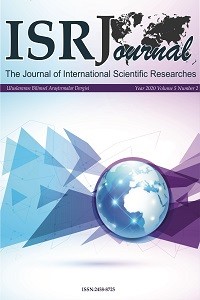Abstract
In this article, the patterns of the Turkish narrative tradition in Messenger, written by Çağan Irmak in 2008, are examined. In addition, the traces of our narrative tradition will be examined in the subject of Messenger film and the opportunities it offers to the cinema narrative will be evaluated. One of the oldest narrative examples with mythology and epics, the fairy tale genre is the main theme of the movie Messenger. The film also tells the audience a story in a structural way. Playing the main character of the movie, Zekeriya is a fairy tale narrator and the tales he tells the children form the atmosphere of the movie. The fairy tale narrative, which contains human virtues such as morality, solidarity, love and ancient teachings, becomes magical with the possibilities of cinema art. The portrayal of the tale in different ways in the imagination of children has made the concepts of time and space relative. This relativity is the feature of freely imagining the type of fairy tale. Messengerfilm tries to reflect this relativity to the audience by dividing the imaginations of the children within the cinema. Apart from the fairy tale narration, the rituals, clothing styles and jewellery that resemble shamanic rituals reflect the folklore of Anatolian geography. Apart from this, space designs, language, and mysticism are other elements that support the film’s mystical atmosphere. The messenger film itself has the texture of the Turkish narrative tradition. In this article, we will consider the motifs that give this feature to the film in a more specific way.
Keywords
References
- Alsaç, F. (2018). Dede Korkut hikâyelerinde kültürel bellek bağlamında gelenekler. Journal of Turkish Language andLiterature(2), 17-35.
- And, M. (1985). Geleneksel Türk tiyatrosu. İstanbul: İnkılap Kitapevi.
- Aslan. E. (2008). Türk halk edebiyatı. Ankara: Pegem Akademi.
- Berdibayev, R. (2002). Destan halk hazinesi. Ankara: Yeni Avrupa Yayınları.
- Boratav, P. N. (2006). 100 soruda Türk halk edebiyatı. İstanbul: Akçağ Yayınları.
- Cansever, T. (2006). Mimar Sinan. İstanbul: Albayrak Yayınları.
- Diyarbekirli, N. (1972). Hun sanatı. İstanbul: Milli Eğitim Bakanlığı Kültür Yayınları.
- Ertaş, R. M. (2016). Auteurbir yönetmen olarak Çağan Irmak. Türk Sinema Araştırmaları, 58.
- Esin, E. (2001). Türk kozmolojisine giriş. İstanbul: Kabalcı Yayınevi.
- İliksiz, Y. (2008) Ulak ne anlatıyor ne anlatamıyor, Haber7, http://www.haber7.com/kultur/haber/298684-ulak-ne-anlatiyor-ne-anlatamiyor, Erişim Tarihi 22 Şubat 2020.
- Konuk, A. A. (2009). Mesnevî-i şerîf şerhi tercüme ve Şerh. İstanbul: Kitabevi Yayınları.
- Korkmaz, R. (2016). Arketipselsembolizm açısından Dede Korkut anlatılarındaki yüce-birey ve alp-bilge tipi. R. Korkmaz içinde, Dede Korkut okumaları. İstanbul: Kesit Yayınları.
- Korkmaz, R. (2016). Dede Korkut okumaları. İstanbul: Kesit Yayınları.
- Kudret, C. (2005). Karagöz (Cilt 3). İstanbul: YKY Yayınevi.
- Ögel, B. (2010). Türk mitolojisi. Ankara: 1.TTK.
- Pay, M. (2012). Gölge oyunu ve sinema. Marmara Üniversitesi Sosyal Bilimler Enstitüsü Yüksek Lisans Tezi.
- Sezer, M. A. (2016). Ulak filminde halkbilimi izlekleri. Dicle Üniversitesi Sosyal Bilimler Enstitüsü Dergisi (2), 216- 220.
- Sözen, M. F. (2009). Doğu anlatı gelenekleri ve Türk sinemasının aidiyeti. Marmara İletişim Dergisi (2), 697-715.
- Şapolyo, E. B. (1974). Karagözün tarihi. İstanbul: Türkiye Yayınevi.
Abstract
Bu makalede Çağan Irmak’ın 2008 yılında yazıp yönettiği Ulak filmindeki Türk anlatı geleneğine ait motifler irdelenmektedir. Ayrıca anlatı geleneğimizin izleri Ulak filmi öznelinde incelenerek sinema anlatısına sunduğu imkanlar değerlendirilmektedir. Mitoloji ve destanlarla birlikte en eski anlatı örneklerinden olan masal türü, Ulak filminin ana temasını oluşturmaktadır. Film yapısal olarak da seyircisine masal anlatmaktadır. Filmin ana karakteri Zekeriya, bir masal anlatıcısıdır ve onun çocuklara anlattığı masallar filmin atmosferini oluşturur. Ahlak, yardımlaşma, sevgi gibi insani erdemleri ve kadim öğretileri içerisinde barındıran masal anlatısı, sinema sanatının imkanlarıyla birlikte büyülü bir hal alır. Masalın çocukların hayal aleminde farklı şekillerde canlandırılması zaman ve mekân kavramlarını göreceli hale getirmiştir. Bu görecelik masal türünün özgürce tahayyül edebilme özelliğidir. Ulak filmi, bu göreceliği, sinema imkanları çerçevesinde çocukların tahayyüllerini başlıklara ayırarak seyircisine yansıtmaya çalışır. Filmde masal anlatısı dışında Şaman ayinlerini andıran ritüeller, giyim tarzı ve takılar Anadolu coğrafyasına ait folklorü yansıtmaktadır. Bunun dışında mekân tasarımları, dil, tasavvuf gibi öğelerde filmin mistik atmosferini destekleyen diğer öğelerdir. Ulak filmi başlı başına Türk anlatı geleneğini dokusuna sahiptir. Bu makalede filme bu özelliği kazandıran motifleri daha spesifik bir şekilde ele alacağız
Keywords
Supporting Institution
İstanbul Aydın Üniversitesi
References
- Alsaç, F. (2018). Dede Korkut hikâyelerinde kültürel bellek bağlamında gelenekler. Journal of Turkish Language andLiterature(2), 17-35.
- And, M. (1985). Geleneksel Türk tiyatrosu. İstanbul: İnkılap Kitapevi.
- Aslan. E. (2008). Türk halk edebiyatı. Ankara: Pegem Akademi.
- Berdibayev, R. (2002). Destan halk hazinesi. Ankara: Yeni Avrupa Yayınları.
- Boratav, P. N. (2006). 100 soruda Türk halk edebiyatı. İstanbul: Akçağ Yayınları.
- Cansever, T. (2006). Mimar Sinan. İstanbul: Albayrak Yayınları.
- Diyarbekirli, N. (1972). Hun sanatı. İstanbul: Milli Eğitim Bakanlığı Kültür Yayınları.
- Ertaş, R. M. (2016). Auteurbir yönetmen olarak Çağan Irmak. Türk Sinema Araştırmaları, 58.
- Esin, E. (2001). Türk kozmolojisine giriş. İstanbul: Kabalcı Yayınevi.
- İliksiz, Y. (2008) Ulak ne anlatıyor ne anlatamıyor, Haber7, http://www.haber7.com/kultur/haber/298684-ulak-ne-anlatiyor-ne-anlatamiyor, Erişim Tarihi 22 Şubat 2020.
- Konuk, A. A. (2009). Mesnevî-i şerîf şerhi tercüme ve Şerh. İstanbul: Kitabevi Yayınları.
- Korkmaz, R. (2016). Arketipselsembolizm açısından Dede Korkut anlatılarındaki yüce-birey ve alp-bilge tipi. R. Korkmaz içinde, Dede Korkut okumaları. İstanbul: Kesit Yayınları.
- Korkmaz, R. (2016). Dede Korkut okumaları. İstanbul: Kesit Yayınları.
- Kudret, C. (2005). Karagöz (Cilt 3). İstanbul: YKY Yayınevi.
- Ögel, B. (2010). Türk mitolojisi. Ankara: 1.TTK.
- Pay, M. (2012). Gölge oyunu ve sinema. Marmara Üniversitesi Sosyal Bilimler Enstitüsü Yüksek Lisans Tezi.
- Sezer, M. A. (2016). Ulak filminde halkbilimi izlekleri. Dicle Üniversitesi Sosyal Bilimler Enstitüsü Dergisi (2), 216- 220.
- Sözen, M. F. (2009). Doğu anlatı gelenekleri ve Türk sinemasının aidiyeti. Marmara İletişim Dergisi (2), 697-715.
- Şapolyo, E. B. (1974). Karagözün tarihi. İstanbul: Türkiye Yayınevi.
Details
| Primary Language | Turkish |
|---|---|
| Journal Section | Articles |
| Authors | |
| Publication Date | June 24, 2020 |
| Submission Date | March 10, 2020 |
| Published in Issue | Year 2020 Volume: 5 Issue: 2 |


